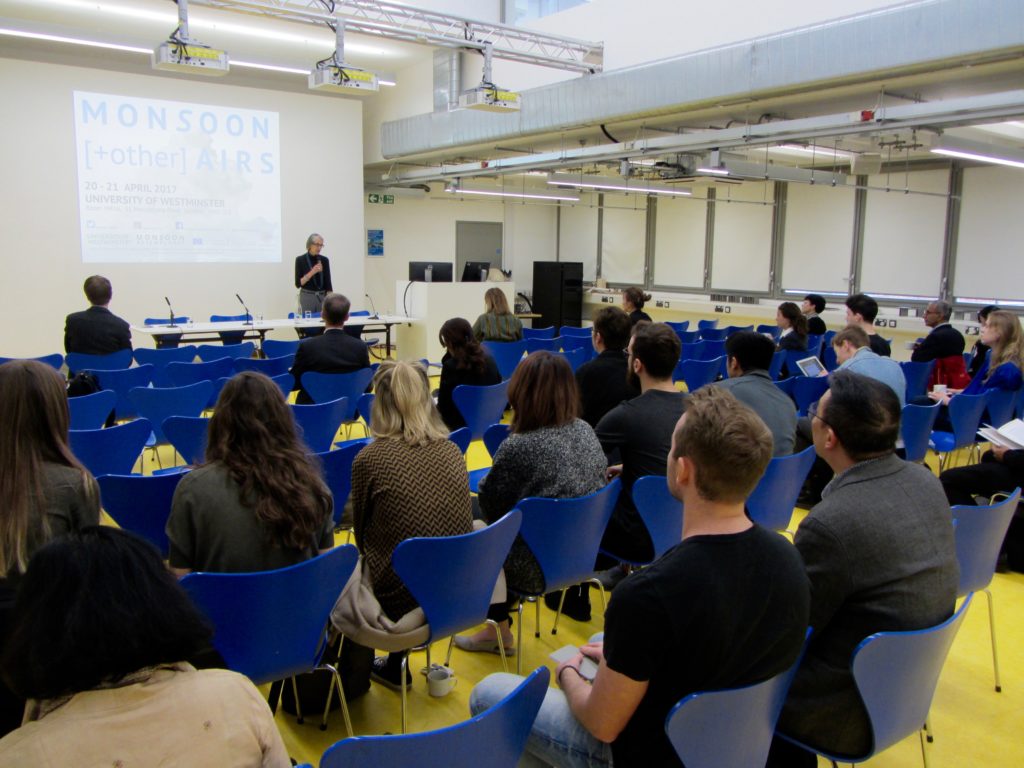
Lindsay Bremner opens the symposium
Air: an invisible gaseous substance surrounding the earth, a mixture mainly of oxygen and nitrogen, necessary for breathing
Monsoon [+ other] Airs is the first of three annual symposia convened by Monsoon Assemblages. Each of the symposiums will be structured around one of the monsoon’s material elements: Monsoon Airs, Monsoon Waters and Monsoon Grounds. This year’s assembly interrogated questions of monsoon atmospheres, airscapes, media and politics. Envisaged as a multidisciplinary gathering, a diverse array of people attended including architects, anthropologists, journalists, meteorologists and designers.
As the programme emerged it became apparent that air, unlike water, has rather escaped people’s attention. As an invisible and diffuse element in some ways this is unsurprising. Nonetheless, air is essential; it surrounds, supports and infuses us, and makes life possible. Perhaps due to its abstract nature, the topic of Monsoon Air was interpreted broadly resulting in thematic panels on air space, weather reports and air politics. In this way, the panel sessions provided a way to bring together people working on air related matters who do not normally speak to one another.
Sean Lally of Weathers, a Chicago-based design office, gave the Thursday evening keynote address. According to Sean, buildings of the future will consist of climate-controlled areas of landscape. His presentation, titled Night White Skies, prompted thought-provoking questions from audience members about the politics of such spaces and the technologies required to make them possible.
For a video of Sean Lally’s keynote lecture go here.
The following day began with Andrew Turner, a meteorologist from Reading University, who introduced people to the monsoon through a scientific lens. Andrew pointed out that although the monsoon is often association with rain, temperature is the real driver; monsoon airs are heated and cooled whilst travelling over land and sea. Andrew’s presentation revealed the complexities of such earth system dynamics. It seems there is still much to be learned in relation to monsoon forecasting and prediction, with current research focusing on how the accuracy of climate models can be improved.
As a member of Design Studio 18 (DS18), co-led by Lindsay Bremner, we are encouraged to use data as a design tool and an approach to architecture. However, we are also encouraged to question and analyse how this data is generated. This directly related to Andrew Turner’s presentation, which described how data was generated to predict monsoon rainfall. Another fascinating talk acknowledged the social and economic aspects of the monsoon through a betting network in Rajesthan. Stine Simonsen Puri discussed her research in the town of Fatephur where locals use their knowledge to bet on rainfall occurrences. This talk offered an alternative view of the monsoon in terms of its scale and temporality, whilst also offering a glimpse into the information systems and speculative economies that revolve around the uncertainly of the monsoon. The symposium also gave me a chance to engage and communicate with speakers and researchers outside the field of architecture, as well as staff from other University faculties. I was lucky enough to interview the keynote speaker for the symposium, Sean Lally, with a fellow student. Meeting Sean, it was clear how passionate he is about his work and research. This experience has motivated and inspired me to become a successful architect in the future.
Tom Benson, MArch student and member of DS18
The Air Space panel was an extraordinary combination of monsoon science by Andrew Turner, innovative representations of pollution and pollen airscapes by Nerea Calvillo and the aesthetics of Yves Klein’s thunder cloud paintings by Victoria Watson. Nerea raised feminist perspectives as well as questions about the politics of data used to “make the air speak”. Victoria’s presentation illustrated the importance of artistic understandings and touched on Klein’s pertinent suspicions about the “miracles of technology”.
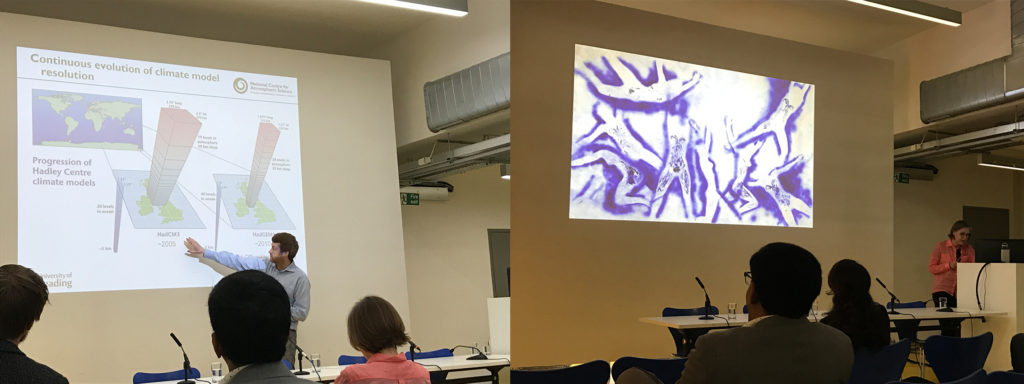
Andrew Turner and Victoria Watson
I attended the Monsoon Assemblages symposium with a little trepidation. How would I be able to communicate the key issues, in monsoon forecasting and modelling for climate change, to an audience largely made of up social scientists and architects? On the other hand, would artistic, architectural and anthropological findings surrounding the monsoon in India be of academic interest to me? I was encouraged to find an engaged and open audience, keen to gain a window into the science upon which we base our estimates of the future of the Indian monsoon.
Andrew Turner, Lecturer in Monsoon Systems, University of Reading
Weather Reports followed with personal reflections by three journalists visiting the University of Westminster on the Chevening Programme, Anasuya Basu, Rifat Islam Esha and Neha Lalchandani, on how the monsoon materialises in their home cities of Kolkata, Dhaka and Delhi. Each of the reports offered insights into dominant media narratives and popular representations of the monsoon, associated urban politics, cultural practices and lived experience from each of the cities.
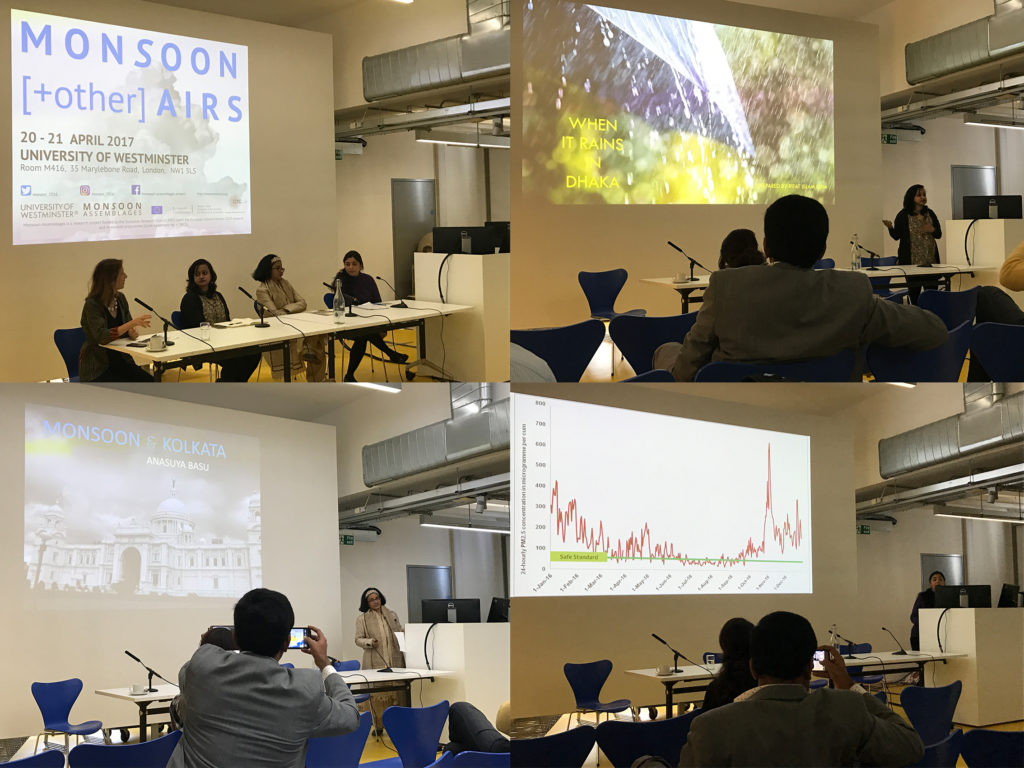
The Chevening Panel: Rosie Thomas (Chair), Rifat Islam Esha, Anasuya Basu, Neha Lalchandani
Afternoon panels on Air Politics featured contributions from anthropology, political science and philosophy. Stine Simonsen Puri gave an inspiring talk about her recent work with monsoon rain bettors in Rajasthan. Harshavardhan Bhat followed with an essay on the “complicit unknowns” of monsoon air drawing on scenes from Karnataka. Hannah Swee presented her ethnographic observations of cyclone forecasting by locals in North Queensland and Etienne Turpin gave an engaging presentation on the politics and problematics of mosquito fogging in Jakarta.
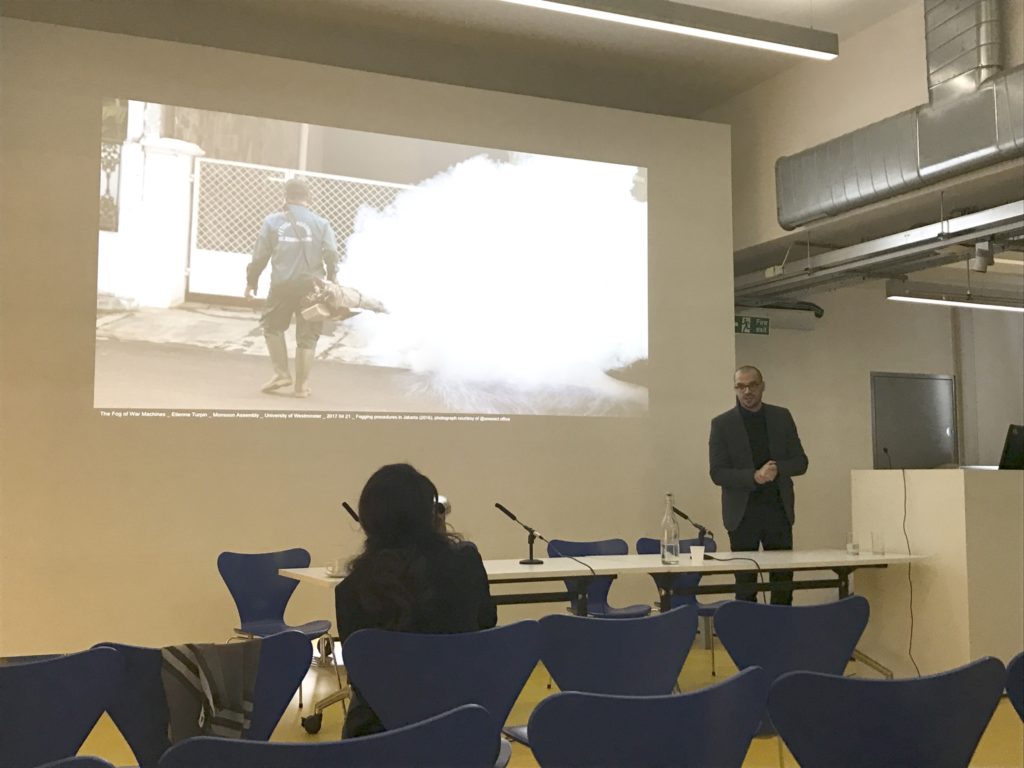
Etienne Turpin on mosquito fogging in Jakarta
Simon Joss, MONASS advisory board member, was invited to sum up the day. In his concluding remarks, the importance of crossing disciplinary boundaries and methodological reflexivity were emphasised. Simon posed interesting questions about how the assemblage concept can be utilised productively to identify opportunities for purposeful intervention, and highlighted challenges around translating research into accessible policy recommendations and making academic discourse accessible to wider publics. We look forward to facilitating further conversations and grappling with these questions as the project continues.
The Monsoon Airs symposium was an extremely inspiring event; one of those rare moments where interdisciplinarity creates synergy and releases creative thinking. Coming from the field of anthropology, I was truly inspired by the visual and material approaches taken by other disciplines. The event not only enabled me to communicate my research on monsoon gamblers, I also developed my analytical arguments through my encounters with different approaches to the monsoon and air.
Stine Simonsen Puri, Postdoctoral Fellow, Copenhagen University.
Presentations were accompanied by a multimedia exhibition including contributions from various speakers and students from the DS18 Master of Architecture design studio. A group of young architects from Chennai submitted a fascinating video on the architectural manifestations of the monsoon in the Srikalahasti temple in Andhra Pradesh. The exhibition was curated by Anthony Powis with support from members of DS18.
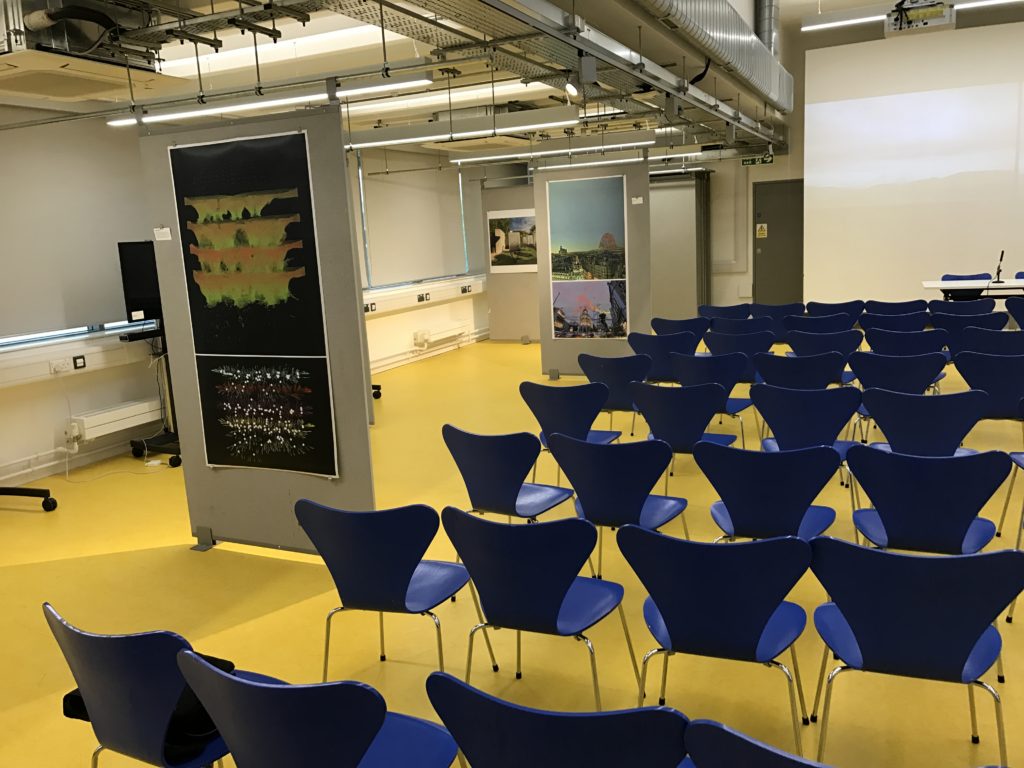
View of the exhibition before the symposium began
Bringing together such diverse perspectives and disciplines within one symposium is highly unusual. Those who attended the event found it to be an intellectually inspiring and stimulating experience that served to open up new ways of thinking. Common threads emerged, connections were made, and important questions were raised about how we might better represent the air, and other more-than-human elements, in our work.
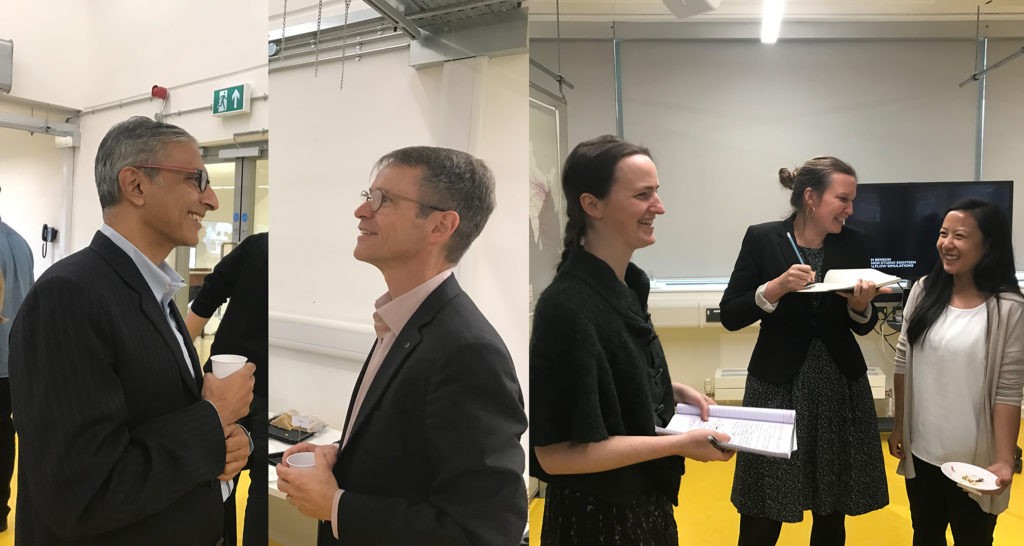
Chella Rajan, Simon Joss, Heid Jerstad, Stine Simonsen Puri, Hannah Swee
The collective of voices and ideas the first Monsoon Assembly brought together inspires the possibility, of a plurality in how we construct the air, the rain, it’s people, it’s objects and the world. Strangely optimistic, the Assembly seems to sift through the complexities of the Air and the Rain in proposing that more can be understood in order to do better things. The venue juxtaposed the exhibition and the performances of the speakers – collaborating two ways of constructing, seeing and listening.
Harshavardhan Bhat, Doctoral researcher, University of Westminster
For more information about the panels and individual speakers see the event programme: Programme170413_web
Videos of the presentations at Monsoon [+ other] Airs will be available on line shortly.
